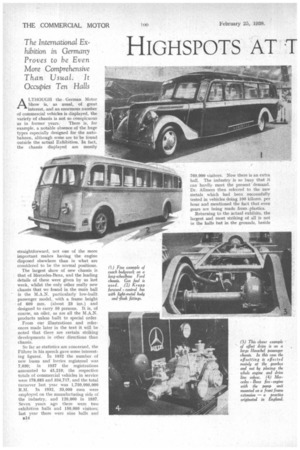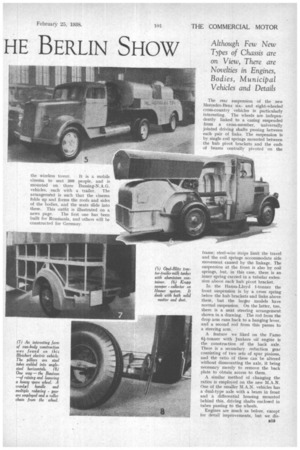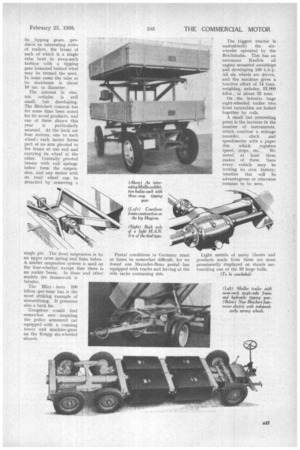HIGHSPOTS AT T HE BERLIN SHOW
Page 52

Page 53

Page 54

Page 55

If you've noticed an error in this article please click here to report it so we can fix it.
The International Exhibition in Germany Proves to be Even More Comprehensive Than Usual. It Occupies Ten Halls Although Few New Types of Chassis are on View, There are Novelties in Engines, Bodies, Municipal Vehicles and Details ALTHOUGH the. German Motor Show is, as usual, of great interest, and an enormous number of commercial vehicles is displayed, the variety of chassis is not so conspicuous
as in former years. There is, for example. a notable absence of the huge types especially designed for the autobahnen, although some are to be found outside the actual Exhibition. In fact, the chassis displayed are mostly straightforward, not one of the more important makes having the engine disposed elsewhere than in what are considered to be the normal positions.
The largest show of new chassis is that of Mercedes-Benz, and the leading details of these were given by us last week, whilst the only other really new chassis that we found in the main hall is the M.A.N. particularly low-built passenger model,. with a frame height of 600 mm. (about 23 ins.) and designed to carry 50 persons. It is, of course, an oiler, as are all the M.A.N. products unless built to special order.
From our illustrations and references made later in the text it will be noted that there are certain striking developments in other directions than chassis.
So far as statistics are concerned, the Fiihrer in his speech gave some interesting figures. In 1932 the number of new buses and lorries registered was 7,030; in 1937 the registrations amounted to 45,219; the respective totals of commercial vehicles in service were 178,685 and 334,717, and the total turnover last year was 1,750,000,000 Rig. In 1932, 33,000 men were employed on the manufacturing side of the industry, and 120,000 in 1937. Seven years ago there were two exhibition halls and 150,000 visitors; last year there were nine halls and 814 760,000 visitors, Now there is an extra hall. The industry is so busy that it can hardly meet the present demand. Dr. Allmers then referred to the new metals which had been successfully tested in vehicles doing 100 kilorns, per hour and mentioned the fact that even gears are being made from. plastics.
Returning to the actual exhibits, the largest and most striking of all is not in the halls but in the grounds, beside the wireless tower. It is a mobile cinema to seat 300 people, and is mounted on three Bussing-NAG. vehicles, each with a trailer. The arrangement is such that the cinema folds up and forms the roofs and sides of the bodies, and the seats slide into these. This outfit is illustrated on a news page. The first one has been built for Roumania, and others will be constructed for Germany. The rear suspension of the new Mercedes-Benz sixand eight-wheeled cross-country vehicles is particularly interesting. The wheels are independently linked to a casing suspended from a cross-member, universally jointed driving shafts passing between each pair of links. The suspension is by single coil springs mounted between the hub pivot brackets and the ends of beams centrally pivoted on the frame; steel-wire strips limit the travel and the coil springs accommodate side movement caused by the linkage. The suspension at the front is also by coil springs, but, in this case, there is an inner spring carried in a tubular extension above each hub pivot bracket.
In the Hausa-Lloyd 1-tonner the front suspension is by a cross spring below the hub brackets and links above the*, but the larger models have normal suspension. On the latter, too, there is a neat steering arrangement shown in a drawing. The rod from the drop arm runs back to a hanging lever, and a second rod from this passes to a steering arm.
A feature we liked on the Famo 6i-tortner with Junkers oil engine is the construction of the back axle. There is a secondary reduction gear consisting of two sets of spur pinions, and the ratio of these can be altered without dismounting the axle, it being necessary merely to remove the back plate to obtain access to them.
A similar method of -changing the ratios is employed on the new M.A.N. One of the smaller M.A.N. vehicles has a dual-type axle with a beam in front and a differential housing mounted behind this, driving shafts enclosed in tubes passing to the Wheels.
Engines are much as before, except for detail improvements, but we dis
covered one of German make that JS new to us. This is the four-cylindered Breuer. It is of 30-35 thh.p., runs at 9,000-3,500 r.p.m., and is intended for private cars and light commercial vehicles. It is of the Oherhanslie type with a separate steel-cup ante-chamber. The valves are overhead and aluminium pistons are used.
The Krupp street cleaner, on the Heuser system, is a clever type of municipal vehicle. Projecting from a casing at the back is a horizontal brush of large diameter which deals with the more solid matter. At the front are small brushes rotating around vertical axes; these also discharge into the main reservoir. Dust and the larger particles of solid matter are drawn by a fan into a series of what are known as cyclones, in which are baffles, and 90 per cent, of the solid matter falls into a bunker below these, the remaining 10 per cent. pnssing into a compartment the sides of which constitute large-area filters, so that the air can escape, leaving the dust behind.
Much space is saved by mounting the rear wheels on pivoted tubular casings
which carry the drive. They are located and suspended by light semi-elliptic springs above which are mounted coil compression springs with an hydraulic arrangement for adjusting them to the load. This vehicle is driven by compressed gas.
Krupp stages a fine 37-seater bus with a 90 b.h.p. Junkers engine. The engine is enclosed in the cab, and the sliding door at the front is air-operated and controlled from the interior by turning a knob. The appearance is improved by making the radiator and lamps flush with the front. This B16
machine can travel at 80 k-iloms. per hour.
A most unusual engine is the Hulse
bos-Hesselman swash-plate type. It has five cylinders and, in many respects, resembles the Bristol type, but is claimed to embody improvements on this and other. designs. The first production engine is of 3.9-litre capacity and develops 75 b.h.p. at 2,500 r.p.m. It has been run up to a maximum of 3,000 r.p.m., and between 1,800 r.p.m. and 2,500 r.p.m. the m.e.p. is said to be 105 lb. per sq. in„ the compression ratio being 6-1. It runs on oil, and an example has achieved 30,000 kiloms, in a lorryweighing about 2i tons, the fuel consumption being one gallon per 30 miles. The first experimental model of this type was a three-cylindered pattern, and was built three years ago, the Dutch Government paying for its development. We hope to give further details shortly.
Of the passenger vehicles, one of the most novel is the Ganbschat, known as the omnibus-train. It consists of a bus and a trailer coach with an accordion-type gangway between them. The trailer wheels are steered from the double drawbar, which not only allows improved tracking but permits reversing without difficulty.
We were particularly struck by tile Mercedes-Benz tractor-trailer with a Gaubschat body magnificently equipped for the display of all types of clocks and watches, some accommodated in cases embodied in the sides, others on interior wall brackets, shelves, etc.
The Meiller concern, well known for its tipping gears, produces an interesting series of trailers, the frame of each of which is a single tube bent in swan-neck fashion with a tipping gear mounted behind what may be termed the neck. In some cases the tube at its maximum is about 10 ins, in diameter.
The interest in electric vehicles is still small,but developing. The Bleichert concern has for some time been noted for its novel products, and one of these shown this year is particularly unusual. At the back are four motors, one to each wheel ; each motor forms part of an arm pivoted to the frame at one end and carrying its wheel at the other. Centrally pivoted beams with coil springs below form the suspension, and any motor with its road wheel can be detached by removing a single pin. The front suspension is by an upper cross spring and links below. A similar suspension system is used on the four-wheeler, except that there is no rocker beam. In these and other models the framework is tubular, The Blitz Aero 100 kilotn.-per-hour bus is the most striking example of streamlining. It possesses also a back fin.
Gangsters would find somewhat awe inspiring the police armoured car equipped with a conning tower and machine-guns on the Krupp six-wheeled chassis. Postal conditions in Germany must at times be somewhat difficult, for we found one Mercedes-Benz postal bus equipped With tracks and having at the -side racks containing skis. The biggest tractor is undoubtedly the sixwheeler operated by the Reichsbahu. This has an enormous Kaelble oil engine mounted amidships and developing 180 h.h.p. All six wheels are driven, and the machine gives a tractive effort of 14 tons, weighing, unladen, 21,000 kilos., or about 22 tons.
On the Schmitz huge eight-wheeled trailer two front turntables are linked together by rods.
A small but interesting point is the increase in the number of instruments, which combine a mileage recorder, clock and speedometer with a paper disc which registers speed, stops, etc. We noted at least three makes of these. Soon every vehicle may be writing its own history; whether this will be advantageous or otherwise remains to be seen.
Light metals of many classes and products made from them are most prominently displayed on stands surrounding one of the 10 large halls.
































































































